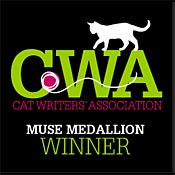 It’s been a month since I brought out Book 30—Revenge at its Felinest and two months since the Meowmoirs of a Klepto Cat debuted. And I’m hard at work on the next Klepto Cat Mystery, tentative title—Cats Don’t Squeal. Like it?
It’s been a month since I brought out Book 30—Revenge at its Felinest and two months since the Meowmoirs of a Klepto Cat debuted. And I’m hard at work on the next Klepto Cat Mystery, tentative title—Cats Don’t Squeal. Like it?
I’m happy to see that both Books 29 and 30 have garnered all 5-star reviews—so far. Yay!
So where am I with the book in progress? Let’s see if I can break my process down for you. First I come up with a basic story idea—whether it’s Rags’s humans and friends taking him camping, using Rags to flush out a kidnapper, a theme based in an eerie old mansion which conceals many secrets that Rags will reveal, or maybe initiating a drama around Rags’s friendship with Savannah’s horse, Peaches. So first, I determine where the story will take place, with which characters, and I start exploring plot ideas. Sometimes I do a simple outline, but generally, I just start writing and the story lines begin to emerge. That’s phase one.
Secondly I take the best ideas and start running with them—writing dialog and action into  the developing story.
the developing story.
Once I have the shell of the story, which might involve sixty pages or even a hundred, I go back and begin the organization—making sure facts fit and match—so that the story line continues to have relativity, interest, and suspense. Facts are extremely important in fiction. If you write about a certain time period or automobile or weapon or fashion, it had better include correct information. I continually check facts—when did they stop making the Jeep Liberty, for example, what time period was a certain style furniture or fashion popular, what is a certain coat pattern on a cat called? (Sure I take time out to play with kittens every chance I get.)
Once the story is in place, I often make one full sweep through the manuscript to make sure the timeline is correct—that Thursday always follows Wednesday, for example, or if something is supposed to happen on Saturday that the countdown to that day is correct. Don’t want to confuse readers.
 Next comes the massaging. I might decide there’s not enough Rags in a story, so I’ll give him something more to do. I may feel there’s too much dialog in one section that sort of makes the story drag rather than move it forward, so I’ll adjust that. Sometimes I create a new twist or turn just because I can and it sounds fun.
Next comes the massaging. I might decide there’s not enough Rags in a story, so I’ll give him something more to do. I may feel there’s too much dialog in one section that sort of makes the story drag rather than move it forward, so I’ll adjust that. Sometimes I create a new twist or turn just because I can and it sounds fun.
After that, it is pure editing—numerous reads for editing. When I can read through the manuscript without making too many changes, I turn it over to one or more readers. This gives me a chance to distance myself from the story. By the time the readers report back to me, I’m ready to edit again, considering some of their suggestions and impressions. At the end of that process, the manuscript is ready for the editor.
I get it back from her in about two weeks and I go through the editing process again as few as two more times and as many as five or six.
When I feel it’s ready, I turn the manuscript over to a formatter who prepares it for Kindle publication and a page layout person who prepares it for print. The layout person prints out the book as it will look when published and I go through that with a fine-tooth comb—yes, reading it word for word, scene by scene again once and sometimes more than once.
In the meantime, I’ve been working with the cover designer to develop the purrfect cover. And once all of the elements are in place, we publish. That’s when I start spreading the word to all of you who enjoy reading my stories…thank you, very much!!!
By then, I’ve pretty much outlined or at least have thought about a theme or destination for my next Klepto Cat Mystery. You keep reading them and I’ll keep producing them.
Klepto Cat Mystery website: http://KleptoCatMysteries.com





